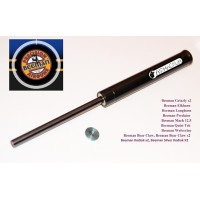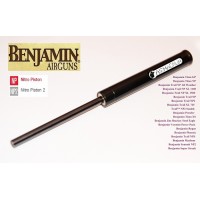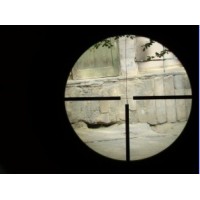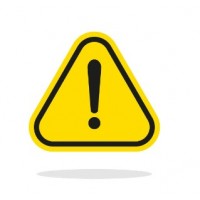Ballistic pendulum
Ballistic pendulum
Measuring the speed of a bullet with a pendulum is available and serious.
Probably, before any owner of pneumatic weapons the question arises - what is the real power of his pistol, rifle? Did it really get better from replacing the seals, tightening the spring, or did all the operations go to increase the volume of the shot? How to check the stability of the bullet velocity from shot to shot? How do I catch the striker force / position setting with the optimal / maximum bullet velocity? All these questions could be answered by a chronograph - a device that measures the speed of a bullet. But even a chronograph, if available, sometimes turns out to be powerless - in a barrel-mounted version, the device can react to a dense cloud of CO2 exhaust from gas-cylinder pistols, rifles and show both overestimated and underestimated speeds. This is especially true for CO2 pistols and you can only trust the readings of a barrel chronograph on a gas cylinder weapon only after rechecking the speed readings. Fortunately, there is another - available and very accurate method of determining the speed of a bullet - the ballistic pendulum.

 ith a pendulum you
ith a pendulum you

With a pendulum you can:
accurately measure bullet velocity (average velocity in a series) with careful measurement of all parameters
not worrying too much about the accuracy of measurements, roughly determine the speed of the bullet to ensure that your device is within the range of the stated specifications.
without going into precise measurements of the parameters of the pendulum and not being interested in the absolute speed of the bullet, check the effectiveness of the changes made to the design - if the pendulum with the same bullets began to deviate further, then the power has objectively increased. Thus, you can, for example, select the optimal position of the electromagnet on the Drozda and set the power regulator.
objectively check whether the barrel chronograph reacts to the exhaust of gas cylinder weapons by comparing the chronograph reading with the pendulum result. It is even possible not to measure the parameters of the pendulum, but to calibrate the deflection of the pendulum by firing through the chronograph with the same bullets from PP or compression weapons.
On the one hand, the pendulum method is simple and affordable, on the other hand, for a good, accurate result, accurate measurement of all parameters is required. So, the stages of the long journey:
Pendulum suspension. It can be any material in which a bullet gets stuck and remains. Bullets should not bounce off the pendulum - this will DEPEND the result. It sounds paradoxical, but it is. Optimally - a bar with a cross section of 5 * 5 cm or more. But without fanaticism. A bar with a section of 20 * 20 cm is original and difficult to say how to measure it and how it will affect the result. As a bar, you can take a medicine box and fill it with a bullet-trapping material - plasticine, a little lead. You can take a ready-made metal or wooden block and make a notch at the end for a bullet-trapping layer of plasticine. The weight of the gimbal should be at least 100 grams, optimally up to 300 grams (or up to 600 grams for magnums). With a further increase in weight, the deflection of the pendulum will decrease and it may be difficult to measure these small deviations with high accuracy - for example, it will turn out to be a couple of centimeters with millimeters, the cost of an error will increase. For a pendulum with a low weight, the change in weight will often have to be corrected - every two bullets add about a gram to the pendulum. Also, for a light pendulum, the length of a ruler may not be enough. For a suspension of 230 grams, with 180 cm threads, the deflection of the pendulum will be about 15 cm at speeds close to 170 m / s with bullets. Too large deviations - more than 25 cm can negatively affect the accuracy, too small - increase the error in measuring the deviation. The higher the measurement accuracy of all quantities, the higher the measurement accuracy in general. Therefore, it is worth taking care of accurately measuring the weight of the gimbal. So, an error in weight by 30 grams for a 300 gram suspension will add a measurement error of 10% (+ -10 m / s at 100 m / s). It is best to determine the mass of the suspension to the nearest gram. The methods can be different. For example, if it is impossible to independently measure the weight of the suspension with an accuracy of a gram, then you can use different electronic scales in different stores and take the average value.
The length of the pendulum threads must ensure a distance of at least 180 cm from the suspension axis to the middle (center of gravity) of the bar. It turns out - from the ceiling - to the floor or stools. It works very well to hang a pendulum in a doorway. I have a pendulum hung in the doorway, at the end of the measurements, I just throw it on the mezzanine above the door. Probably, it will be optimal to hang the bar on four threads - the threads on the left side converge together at the upper attachment point, the threads on the right side converge at the top away from the thread attachment point on the left side. (See Fig. 1)
Thus, we eliminate the rotation of the pendulum and reduce parasitic oscillations.
In general, the general recommendations are as follows - having decided on the expected range of speeds, bullet weight, suspension length, you can choose the suspension mass so that the deviations are no more than 20 cm.You can even choose a suspension weight where the suspension deviation in mm will correspond to the speed bullets in m / s. The weight of the suspension (kg) can be calculated as follows:
M = V * m / (S * sqrt (9.81 / L))
Where
V - expected speed in m / s
m - bullet mass, KG (!!!)
S - expected deviation, meters
L is the length of the pendulum (from the swing axis to the central point of the suspension), meters.
We decided on the design of the pendulum.
You will need a ruler and a slider to push the pendulum along the ruler. The surface on which the slider will slide should be smooth. As a slider, you can use the lightest box - for example, a matchbox frame. Even better - a corner of thick paper, set up by a tent between two rulers-guides. With the help of the slider, the pendulum is calmed down and zero is set along the ruler. Then the slider is moved closer to the expected speed value, without bringing a couple of centimeters. This reduces the loss of movement of the slider. In the future, in a series of practical measurements, the distance where to put the slider is determined more precisely and maintained in a uniform manner. Check how the pendulum swings and how the slider pushes. After the shot, using the slider, we determine how far the pendulum has deflected with an accuracy of mm.
The mass of the bullet should be determined. Accurate to the hundredth of a gram. You can use pharmaceutical scales and weigh groups of 10, 20 bullets, get the average. You can take less accurate scales and weigh 100 bullets. You can take someone else's measurement results, but they sometimes do not correspond to reality.
With a control "blank" shot or a shot past the suspension (do not forget about the bullet trap behind the structure), we make sure that the outflowing gases do not affect the deflection of the pendulum. A distance of 1 meter to the muzzle is usually sufficient. We try to shoot along the axis-direction of the deflection of the pendulum and so that the trajectory of the bullet passes through the c.t. suspension. The pendulum, of course, must first be calmed down and adjusted to zero.
How it works. The bullet hits the pendulum and remains in it. This is a completely inelastic blow. Part of the energy inevitably goes into heat, but then we can use the law of conservation of momentum. The momentum of the suspension with the bullet will be equal to the momentum of the bullet before it hits. Those. knowing the impulse (speed) of the suspension, you can find out the impulse (bullet speed). Having received an impulse, which has an analogue in the form of kinetic energy (so far unknown), the pendulum begins to deflect. When deflected, the suspension begins to rise upward, the kinetic energy turns into potential. When the suspension stops (maximum deviation, height), the kinetic energy has completely passed into potential. (Fig. 2)
Having learned the height, we obtain the potential (kinetic at the moment of impact) suspension energy, through the energy - the suspension impulse, through the suspension impulse - the bullet impulse, bullet velocity.
And counting all this is even faster than writing. The complete formula is:
V = ((M + m) / m) * sqrt (2 * g * (L - sqrt (L * L - S * S)))
V - bullet speed, m / s
M - suspension mass, kg
m - bullet mass, kg (KILOGRAMS accurate to the hundredth of a gram)
g - acceleration of gravity, 9.81
L - suspension length, meters
S - deflection of the pendulum, meters. Meters accurate to mm.
A simplified, practical but equally accurate formula:
V = ((M + m) / m) * S * sqrt (g / L)
V - bullet speed, m / s
M - suspension mass, kg
m - bullet mass, kg
g - acceleration of gravity, 9.81
L - suspension length, meters
S - deflection of the pendulum, meters.
Because M + m is much less than M, you can take M / m, but one should not forget that two bullets in the suspension are already about 1 gram plus to the suspension mass.
Do not forget about statistics, the result is not judged by a single shot. Don't forget about safety precautions!
Practice:
Test shot from PSRM with passing measurement through the chronograph:
m = 0.00048 kg (0.48 grams, Gamo Pro Hunter bullet)
M = 0.234 kg (by electronic scales, bar 5 * 5 * 10 cm)
L = 1.868 m (the length of the "thread" was 189.3 cm to the very bottom of the suspension, 184.3 to the point of attachment of the threads to the pendulum)
S = 14.6cm = 0.146m
Vchronograph = 164 m / s
V = (234 / 0.48) * 0.146 * sqrt (9.8 / 1.868) = 163.02 m / s
It can be seen that the pendulum method, with a careful and careful approach, gives very accurate results.
By upgrading, it is possible to determine the relative energy gain without accurately measuring all components. It can be seen from the formula that V depends linearly on S. That is, if, as a result of the upgrade, the pendulum began to deflect twice as much, then the speed also doubled. In this way, for example, the optimal position of the electromagnet in Drozda can be adjusted.
The error in the absolute value of the measured speed can be estimated. The error in measuring the deflection of the pendulum has a linear effect (S + -S error). The error in measuring the mass of the bullet, suspension - also linear (M + -Merrors), the error in measuring the suspension height - is under the root and brings less influence.
The main thing is not to be afraid and not to hesitate to double-check yourself. Not everything is as easy as we would like, but also not as difficult and inaccessible as it might seem. The method works. Electronically tested. Good luck :)
Author: SwD
Having a chronograph, you can simplify your life with a pendulum (for example, for CO2) - without making unnecessary measurements - we calibrate the deflection of the pendulum by firing the same bullet from the PPP / PCP through the chronograph.
Related Products
Gas spring Beeman Kodiak x2, Beeman Silver Kodiak X2
Gas spring for air rifleBeeman Kodiak x2, Beeman Silver Kodiak X2Set:gas springcentering thrust washerinstructionpackaging High pressure gas spring (hereinafter referred to ..
376грн. 398грн.
Gas spring Benjamin Trail NPS
Gas spring for air rifle Benjamin Trail NPS Set: gas springinstructionpackaging High pressure gas spring (hereinafter referred to as HP). It is pumped with ni..
376грн. 398грн.
Related Articles
Order 2001 №53 / 213
Order of the Ministry of Internal Affairs of Ukraine dated 21.03.2001 №53 / 213"On Approval of Licensing Conditions for Economic Activity in Production, Repair of Firearms and Ammunition, Cold Weapons..
How does the wind affect shooting
How the weather affects shooting is known, in all likelihood, even less than the influence of other factors. There are many different considerations and theories as to how best to shoot in the wind an..
Explanatory Dictionary of Pneumatics
.177 - калибр, соответствующий 4,5мм..20 - калибр, соответствующий 5,0мм..22 - калибр, соответствующий 5,5мм..25 - калибр, соответствующий 6,35мм..35 - калибр, соответствующий..
Order 1998 № 622
Затверджено &nb..
Optics selection and sighting
Optics selection and sightingQuite a lot has been written about optical sights, so I see no reason to dwell on their device in detail again. We will talk about the problems that you will have to face ..
Ballistics of pneumatic weapons
At one time, a cowboy philosopher expressed the "wise" idea that the shortest distance between him and the target is a bullet. He was probably thinking of an imaginary straight line connecting th..
Parallax
Parallax is a phenomenon found when observing the surrounding space, which consists in a visible change in the position of some fixed objects relative to others located at different distances from eac..
Shooting precipitation
Light to moderate rain improves shooting conditions for three reasons: clouds, rain reduce or negate the effect of the mirage. Rain can be a pretty good indicator of wind, rain helps you defeat your o..
Safety Measures & Warnings
• This air gun will shoot if cocked, loaded, safety disengaged and trigger pulled.• Air guns are not toys. Never let young children use an air gun unsupervised. Adult supervision is strictlyrequired d..
Care, Cleaning and Lubrication of Air Rifles
• Periodic lubrication will help you increase the longevity of your rifle. Lubrication is required if: • the shot was not fired for a long time. &..











